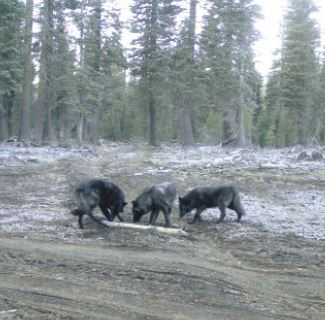
This “trailcam” photo from the state Department of Fish and Wildlife shows wolves from the Shasta Pack—one of two known packs in California. The Shasta Pack is suspected of killing livestock. The state’s first confirmed livestock kill was attributed to the other pack, the Lassen Pack.
November 9, 2017 - By Noelle Cremers - Almost exactly six years ago, California had its first wolf visitor come into the state from Northeastern Oregon. Since OR-7 first entered California, the state Department of Fish and Wildlife has identified two separate packs in Northern California—and each pack has either been suspected or confirmed of killing livestock.

(Left) Noelle Cremers, director of natural resources and commodities for the California Farm Bureau Federation
The state's first established wolf pack, the Shasta Pack, probably killed a calf on a ranch in Siskiyou County in 2015. The Shasta Pack's whereabouts is currently unknown, although offspring of that pack have been seen in other parts of California and Nevada.
In 2016, a male and female wolf pair was identified in Lassen County; that pair had pups earlier this year, at which point the pack was named the Lassen Pack. Last month, DFW confirmed that the Lassen Pack had killed a heifer grazing on private land in Lassen County. This was the first time since OR-7 entered California that DFW confirmed the death of livestock by wolves.
Although DFW had issued a news release confirming presence of the Lassen Pack and featuring photos of the pups, the department declined to issue a release about its determination that the pack had killed the heifer. That seemed newsworthy to Farm Bureau, so we cooperated with the California Cattlemen's Association to issue a joint news release announcing the confirmed wolf kill.
As California Farm Bureau Federation President Paul Wenger said in the release, "It's important for Californians to understand the full implications of the wolf's return."
California livestock producers certainly understand. Their operations will be affected, both by wolves injuring or killing livestock, and indirectly, because the threat of wolves can cause livestock to gain less weight and be less likely to get pregnant.
A peer-reviewed paper documented ranches in Western Montana that had suffered a confirmed wolf depredation had calves gain 22 pounds less on average than they would have gained had wolves not been present. For the average ranch included in the study, the lower weight gain worked out to a loss of approximately $6,679, based on cattle prices at the time.
Montana has a compensation program for confirmed livestock losses—though the study showed it only covered 13 percent of ranchers' losses. In California, ranchers have no access to funds to compensate for wolf-caused losses. Not only that, but wolves are protected under both the federal and state Endangered Species Acts, making it illegal to injure or kill them to protect livestock.
CFBF and CCA are pursuing a lawsuit, challenging the listing of wolves under the California Endangered Species Act. Some people have charged that we just want to slaughter wolves to protect our own economic interests. That's not the aim. The aim is to give ranchers and livestock more flexibility in co-existing with wolves.
The wolves' listing means ranchers have limited options to protect their animals.
There are tools that can help protect livestock in certain situations, but the available options are very site-specific and won't work at all times or in all situations. Tools include visual deterrents—automatic lights, fladry, etc.—and audible deterrents, such as radio-activated guard boxes, propane cannons and so on. Removing livestock carcasses and bone piles is thought to help reduce attractants for wolves and prevent them from coming in contact with livestock. Livestock guard dogs can be helpful in some situations, but they are also at risk of being injured or killed by wolves. Using range riders to increase human presence can be helpful in reducing losses, or at least identifying losses quickly.
All of these tools pose unique challenges to implement. For example, putting up fladry around a 5,000- or 10,000-acre pasture is not possible, given the costs and rough terrain in areas where wolves have established themselves. With the costs and drawbacks of all of these tools, ranchers are often reluctant to implement them until wolves are present.
When wolves are near livestock, it is legal to haze them away with non-injurious methods. However, that requires continuous monitoring because non-injurious harassment of wolves is only allowed within a quarter-mile of livestock. When it is used, it is limited to scaring wolves away by chasing them, making loud noises or using spotlights.
Information on wolf locations needs to be shared early and often with livestock producers, to allow them time to take action if there are tools that could work for their situation.
If a rancher has any suspicion that an animal may have been killed by wolves, he or she should contact DFW or USDA Wildlife Services to report the death. The scene of the kill should also be protected to ensure evidence is available to make a determination on cause of death.
In that circumstance, ranchers should avoid walking in and around the area; keep dogs and other animals away, to avoid disturbance; place a tarp or other cover over the carcass; and preserve potential tracks and scats by covering them with cans or buckets.
Farm Bureau is committed to continuing to work with DFW to figure out ways to reduce the burdens of raising livestock in areas with wolves—but we do not expect it to be easy.
(Noelle Cremers is director of natural resources and commodities for the California Farm Bureau Federation. She may be contacted at ncremers@cfbf.com.)
Reprinted with permission: California Farm Bureau Federation
